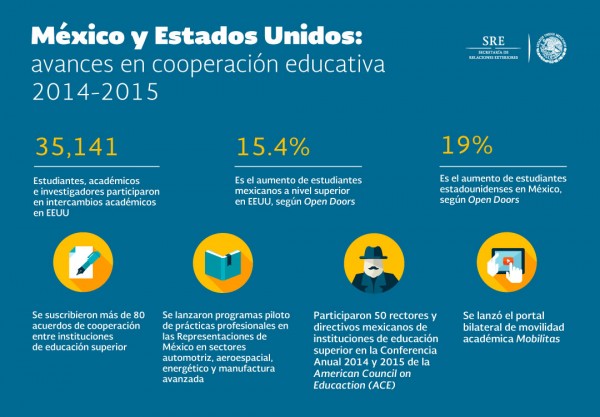
The United States and Mexico are political allies and neighbors with intertwined economies. They both need and at times compete for talent, capital and investments in new technologies. In 2013, the Obama and Peña Nieto administrations launched the High Level Economic Dialogue, a cabinet-level vehicle for deeper engagement on economic issues, and the Bilateral Forum on Higher Education, Innovation and Research, a parallel effort to increase academic and scholarly exchanges between the United States and Mexico. Part of this effort involves cooperation with non-governmental actors to encourage meaningful exchanges among students, faculty and staff from U.S. and Mexican educational institutions at all levels of higher education.
Academic exchanges between countries are critical for robust collaborations in education, research and technological and economic innovation. Regular exchanges and movement of faculty and students back and forth promotes cultural understanding and deeper understandings of each country’s educational and research practices and technologies. Researchers learn about the lines of inquiry that drive innovation in both countries. Over the long term, transnational social and academic networks are strengthened – as has happened before through academic exchanges such as those orchestrated between the United States and Russia and the United States and China.
What are the key challenges and opportunities for leaders trying to strengthen academic ties between the United States and Mexico? Some answers can be found in institutional surveys conducted at Rice University in 2013 and 2014. The results show that, so far, transnational exchanges are hampered by limited communication, inadequate funding, and perceptions of insecurity in Mexico. But important opportunities remain to make progress in the future.
Significant Challenges and Opportunities for Mobility
Repeatedly, people in institutions of higher education in the United States and Mexico profess a lack of knowledge about their peer institutions abroad and the best modes of collaborating with them. Lack of communication, broadly understood, is a key barrier for Mexican institutions and for their U.S. counterparts as well. The survey findings also reveal the importance of binational relationships among faculty members. Forums such as the Puentes Consortium provide opportunities for dialogue about educational exchanges. Student and faculty exchanges can be furthered by commitment from higher educational institutions and academic departments as well as by the development of binational consortia and networks.
U.S. and Canadian higher education systems have already developed similar requirements for earning degrees and for accrediting institutions through the American Association of Universities. But Mexican institutions are not members of this organization. In the future, they could be brought into fuller alignment with their north American counterparts by using participation in the American Association of Universities to facilitate standardization of academic programs.
Language differences also matter – creating both barriers and opportunities. In one sense, language differences make it harder for academic institutions to communicate with one another. And to attend the other country’s institutions, students from Mexico need some facility in English while students from the United States need to learn Spanish. However, the desire to deepen language skills is also a key spur for students to study abroad.
Higher education mobility is related to binational workforce planning and patterns of migration. International trade is strengthened by the mobility of human capital. Governance and leadership at multiple levels – in higher education institutions, nations, and regions cooperation – can further reforms and ties with clear pay-offs for economic development and mutually beneficial relationships between Mexico and the United States.
Best Practices and Recommendations
The idea of a “Region of Knowledge” recently proposed by the Mexican government is similar to the idea of a Europe of Knowledge proposed by the European Commission in 1997. Subsequently, European educational leaders have made progress in harmonizing higher educational arrangements and promoting global cooperation among 47 cooperating countries. The ultimate aim is to allow mutual recognition of academic degrees in an increasingly integrated global economy.
Given successes in building international ties elsewhere, many opportunities clearly remain to improve academic cooperation and exchanges between Mexico and the Unites States, despite the slow progress so far. Based on what we have learned, the following steps make sense for institutional leaders working closely with public sector agencies and private sector investors and funders:
- Create a framework for higher education mobility that is voluntary and flexible over time that includes a loosely coordinated central entity to encourage binational dialogue
- Identify specific academic fields that would benefit most from bilateral collaboration. For those fields, build higher education clusters to support exchanges and regional development
- Develop government support for transnational cooperation in partnership with institutions of higher education, industry and other important actors
- Build institutional diversity into transnational academic cooperation by including technical and community colleges, four-year teaching institutions, and research universities
- Prioritize language study as the foundation for improved economic competitiveness and the long-term development of ties between Mexico and the United States
For more, read Vassar, David and Beverly Barrett. 2014. “U.S.-Mexico Academic Mobility: Trends, Challenges, and Opportunities.” Issue Brief no. 08.20.14. Rice University’s Baker Institute for Public Policy, Houston, Texas.

 Research to Improve Policy: The Scholars Strategy Network seeks to improve public policy and strengthen democracy by organizing scholars working in America's colleges and universities. SSN's founding director is Theda Skocpol, Victor S. Thomas Professor of Government and Sociology at Harvard University.
Research to Improve Policy: The Scholars Strategy Network seeks to improve public policy and strengthen democracy by organizing scholars working in America's colleges and universities. SSN's founding director is Theda Skocpol, Victor S. Thomas Professor of Government and Sociology at Harvard University.